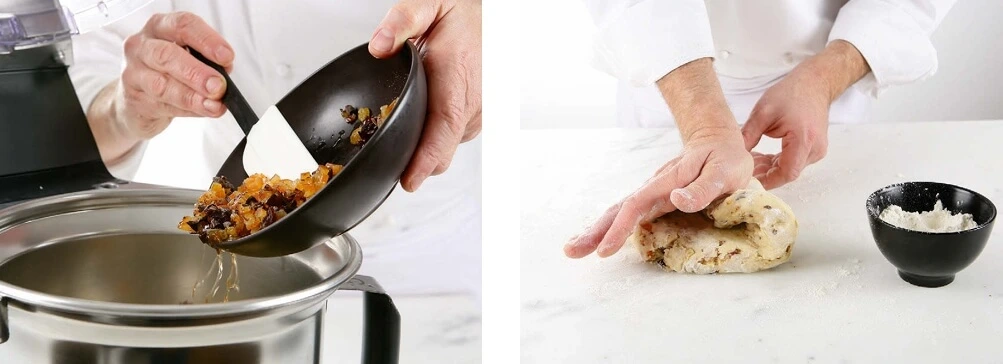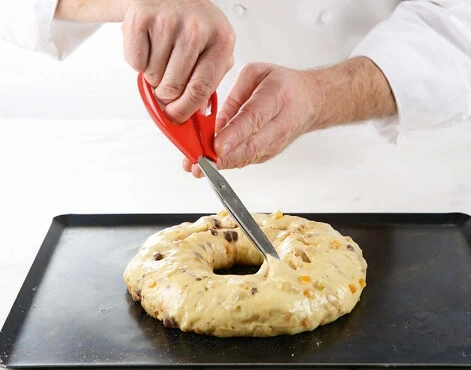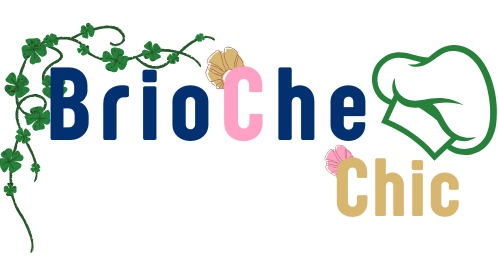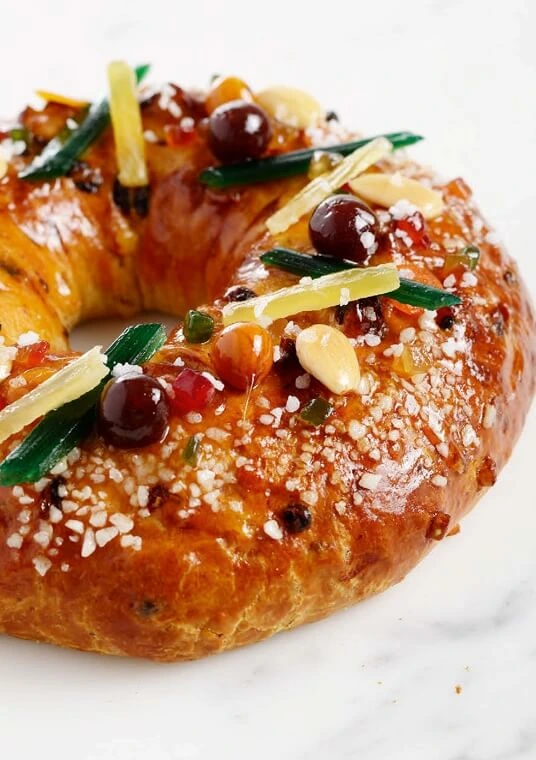Kougelhopf is more than just a cake — it is a symbol of heritage and celebration, deeply rooted in the cultural tapestry of Alsace and neighboring regions. Its iconic fluted shape, reminiscent of a crown or a festive wreath, evokes centuries of tradition and craftsmanship passed down through generations.
This baked masterpiece captivates not only by its distinctive silhouette but also by the remarkable contrast of textures and flavors it offers. The exterior, golden and delicately crisp, gives way to a tender, airy crumb that is both buttery and subtly fragrant. Each slice reveals a tender crumb that is light yet rich, embodying a perfect balance between indulgence and refinement.
Often enjoyed during holidays or special occasions, Kougelhopf carries with it an air of conviviality and warmth, inviting friends and family to gather around the table and share in its simple pleasure. Its presence on the table is a nod to timeless artistry — the kind that transforms humble ingredients into a cherished centerpiece, rich with history and soul.
Whether savored for breakfast alongside a steaming cup of coffee or as an afternoon treat, Kougelhopf offers a moment of gentle luxury, a pause to appreciate the delicate craftsmanship and heartfelt tradition that make this cake a true classic of French pastry.
Kougelhopf Recipe Overview (Serves 4 to 6)
- Preparation Time: 1 hour
- First Proofing (Pointage): 1 hour
- Refrigeration: 30 minutes
- Second Proofing (Pousse): 2 hours
- Baking Time: 45 minutes to 1 hour
- Storage: Best consumed within 1 to 3 days for optimal freshness
Essential Equipment
- Stand mixer (robot pâtissier) — to achieve the perfect dough texture with ease
- Traditional 20 cm diameter earthenware Kougelhopf mold — for that iconic fluted shape and ideal heat distribution
- Pastry brush — for glazing and finishing touches
Ingredients
- 100 g golden raisins
- 18 g kirsch (cherry brandy)
- 250 g flour
- 15 g fresh yeast
- 6 g salt
- 50 g egg (about 1 large egg)
- 75 g whole milk
- 40 g sugar
- 75 g sourdough starter (optional)
- 125 g butter
- 25 g raw almonds
Kirsch Syrup
- 100 g water
- 80 g sugar
- 10 g kirsch
Finishing
- Sufficient quantity of melted butter
- Sufficient quantity of powdered sugar
Preparation Method
Begin by plumping the golden raisins: immerse them in boiling water and let them soak gently for about 30 minutes. Once rehydrated, drain thoroughly and transfer the raisins to a small bowl to macerate in kirsch, allowing them to infuse with the rich cherry brandy aroma while you prepare the dough.
In the bowl of your stand mixer fitted with a dough hook, prepare the poolish starter by combining the milk, flour, and fresh yeast. Mix at low speed for no more than 5 minutes, just until the mixture forms a smooth and homogeneous batter. Cover the bowl tightly with cling film and allow the poolish to ferment at room temperature for approximately 1 hour and 30 minutes, until it has visibly risen and developed bubbles.
Once the poolish is ready, add all the remaining brioche dough ingredients except for the butter into the mixer bowl. Begin kneading on low speed for about 7 minutes to combine, then increase to medium speed and continue kneading for an additional 10 minutes. The dough should become elastic and smooth. Gradually incorporate the butter in small pieces, continuing to knead gently until fully incorporated. Finally, fold in the kirsch-soaked raisins and almonds, mixing just enough to distribute them evenly without overworking the dough.

Transfer the dough to a lightly floured work surface or tray, cover, and allow it to proof at room temperature for 1 hour, during which the dough will continue to rise and develop flavor.
Next, gently degass the dough by folding it over itself to release excess gas. Cover tightly and place in the refrigerator for a minimum of 2 hours, or preferably overnight — this cold rest will enhance flavor complexity and dough strength.
When ready, remove the dough from the refrigerator and shape it into a smooth ball. Using your thumb, carefully create a hole in the center of the dough ball. Stretch the dough gently to form a ring or crown shape, ensuring even thickness all around.

Place the shaped dough into a traditional fluted Kougelhopf mold, previously buttered, and allow it to rise for 2 hours in a warm, humid environment. You can create this by placing the mold in an oven set to 26°C (about 78°F) with a container of boiling water inside to maintain humidity.
Once the dough has sufficiently proofed and almost doubled in size, use a pastry brush to glaze the surface with egg wash, giving it a beautiful golden finish. Using kitchen scissors, carefully make decorative incisions along the edges to enhance its characteristic look.

Sprinkle generously with pearl sugar for a delicate crunch and a touch of sweetness.
Bake the Kougelhopf at 140°C (about 285°F, oven setting 4/5) for 20 minutes. Once baked, carefully remove the cake from the oven and transfer it onto a wire rack to cool completely.
For a finishing touch, decorate the cooled Kougelhopf with an assortment of dried fruits and candied peel, adding vibrant color and festive flair.
Professional Tip:
When incorporating the soaked fruits into your dough, it is crucial to handle them with the utmost care. Avoid mixing them too vigorously or for too long in your stand mixer, as the mechanical action can easily break down the delicate texture of the fruits, turning them into an unwanted puree rather than maintaining their desirable plumpness and bite. To preserve their integrity and ensure each piece remains distinct, fold the macerated fruits gently and briefly by hand or at the lowest mixer speed, just until evenly distributed. This subtle technique guarantees a perfect contrast in texture throughout your Kougelhopf, elevating the overall eating experience
Conclusion
The Kougelhopf is much more than a traditional cake; it is a celebration of history, craftsmanship, and the art of patience. Each step in its preparation—from the delicate soaking of golden raisins in kirsch to the slow, careful folding of butter into the enriched dough—reflects a timeless dedication to quality and technique. The dough’s long fermentation and multiple proofs not only develop complex flavors but also create the light, tender crumb that defines this iconic Alsatian specialty.
Baking Kougelhopf is an invitation to slow down and savor the process, honoring the harmony between texture, aroma, and taste. The final product is a stunning visual masterpiece with its elegant fluted shape and glistening pearl sugar topping, a treat that enchants the senses and invites conviviality.
Whether served for a festive occasion, a leisurely brunch, or an afternoon tea, Kougelhopf offers a perfect balance of rustic charm and refined sophistication. It is a reminder that the most memorable dishes are those made with patience, respect for tradition, and a touch of love.
By mastering this classic, you not only bring a piece of Alsace to your table but also carry forward a culinary legacy that continues to delight and inspire. So take your time, relish each moment, and let every bite tell a story of heritage and craftsmanship.
Frequently Asked Questions (FAQ) – Kougelhopf
Q1: Can I use dried fruits other than golden raisins in this recipe?
A: Absolutely. While golden raisins are traditional, you can experiment with other dried fruits such as currants, chopped dried apricots, or cherries. Just make sure to soak them adequately to ensure they remain plump and juicy in the final cake.
Q2: Is it possible to make Kougelhopf without fresh yeast?
A: Yes, you can substitute fresh yeast with active dry yeast. Use about one-third of the fresh yeast weight and activate it in warm milk before adding to the dough. The rising times may be slightly longer, so monitor the dough’s volume rather than the clock.
Q3: What is the purpose of the refrigeration step during dough preparation?
A: The refrigeration slows down fermentation, allowing the dough to develop deeper flavors and a more complex texture. It also makes the dough easier to handle and shape, resulting in a better final structure.
Q4: Can I use a different type of mold if I don’t have a traditional earthenware Kougelhopf mold?
A: Yes, you can use any fluted tube pan or Bundt pan with a similar shape to achieve the classic form. Just be sure to thoroughly grease the mold to prevent sticking.
Q5: How long can I keep Kougelhopf fresh?
A: Kougelhopf is best enjoyed within 1 to 3 days. To preserve freshness, store it in an airtight container at room temperature. Avoid refrigeration as it may dry out the cake.
Q6: Can Kougelhopf be frozen?
A: Yes, you can freeze Kougelhopf wrapped tightly in plastic wrap and placed in a freezer bag. Thaw it gently at room temperature before serving. Note that texture may slightly change after freezing.
Q7: What drinks pair well with Kougelhopf?
A: This cake pairs beautifully with light teas, coffee, or a glass of Alsatian white wine such as Riesling. For a festive touch, serve it alongside a glass of sparkling wine.

